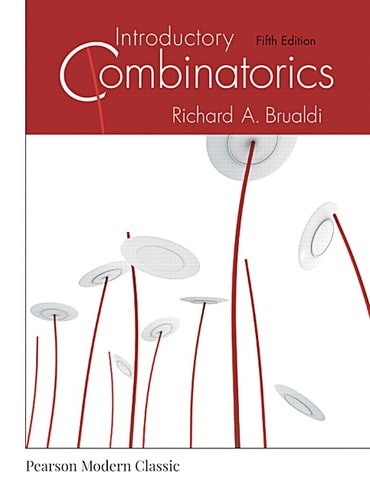
Introductory Combinatorics (Classic Version), 5th edition
Title overview
For 1- or 2-semester, junior/senior-level courses in Combinatorics.
A modern classic
Introductory Combinatorics covers the key combinatorial ideas–including the pigeon-hole principle, counting techniques, permutations and combinations, Pólya counting, binomial coefficients, inclusion-exclusion principle, generating functions and recurrence relations, combinatorial structures (matchings, designs, graphs), and flows in networks. The 5th Edition incorporates feedback from users to the exposition throughout and adds a wealth of new exercises.
This title is part of the Pearson Modern Classics series. Pearson Modern Classics are acclaimed titles at a value price.
Hallmark features of this title
- Comprehensive, accessible coverage of main topics in combinatorics:
- Provides students with accessible coverage of basic concepts and principles.
- Covers a wide range of topics: Dilworth's Theorem, partitions of integers, counting sequences and generating functions, and extensive graph theory coverage.
- A clear and accessible presentation, written from the student's perspective, facilitates understanding of basic concepts and principles.
- An excellent treatment of Polya's Counting Theorem does not assume students have studied group theory.
- Many worked examples illustrate methods used.
New and updated features of this title
- A wealth of new exercises has been added to this revision.
- Use of the term “combination” as it applies to a set has been de-emphasized; the author now uses the essentially equivalent term of “subset” for clarity. (In the case of multisets, the text continues to use “combination” versus the more cumbersome term “submultiset.”)
- A new section (Section 1.6) on mutually overlapping circles has been moved from Chapter 7 to illustrate some of the counting techniques covered in later chapters.
- Coverage of the pigeonhole principle and permutations and combinations has been reversed; Chapter 2 now covers permutations and combinations, with Chapter 3 covering the pigeonhole principle.
- An extensively revised Chapter 7 moves up generating functions and exponential generating functions to Sections 7.2 and 7.3, giving them a more central treatment.
- Section 8.3 on partition numbers has been expanded; and much more.
Table of contents
-
1. What is Combinatorics?
-
2. The Pigeonhole Principle
-
3. Permutations and Combinations
-
4. Generating Permutations and Combinations
-
5. The Binomial Coefficients
-
6. The Inclusion-Exclusion Principle and Applications
-
7. Recurrence Relations and Generating Functions
-
8. Special Counting Sequences
-
9. Systems of Distinct Representatives
-
10. Combinatorial Designs
-
11. Introduction to Graph Theory
-
12. More on Graph Theory
-
13. Digraphs and Networks
-
14. Pólya Counting
Author bios
About our author
Richard A. Brualdi is Bascom Professor of Mathematics, Emeritus at the University of Wisconsin - Madison. He served as Chair of the Department of Mathematics from 1993-1999. His research interests lie in matrix theory and combinatorics/graph theory. Professor Brualdi is the author or co-author of 6 books, and has published extensively. He is one of the editors-in-chief of the journal "Linear Algebra and its Applications" and of the journal "Electronic Journal of Combinatorics." He is a member of the American Mathematical Society, the Mathematical Association of America, the International Linear Algebra Society, and the Institute for Combinatorics and its Applications. He is also a Fellow of the Society for Industrial and Applied Mathematics.